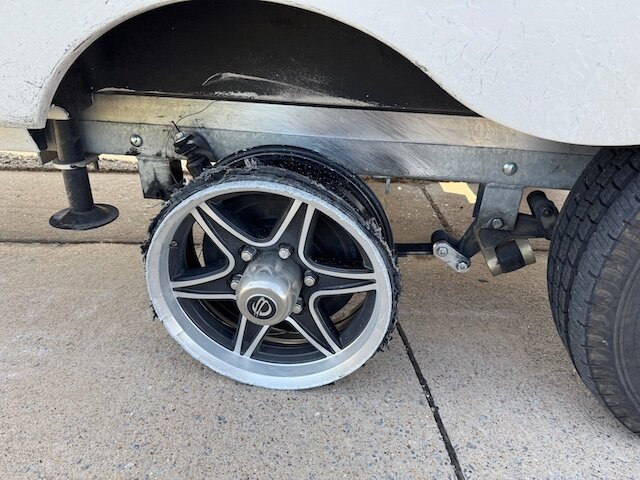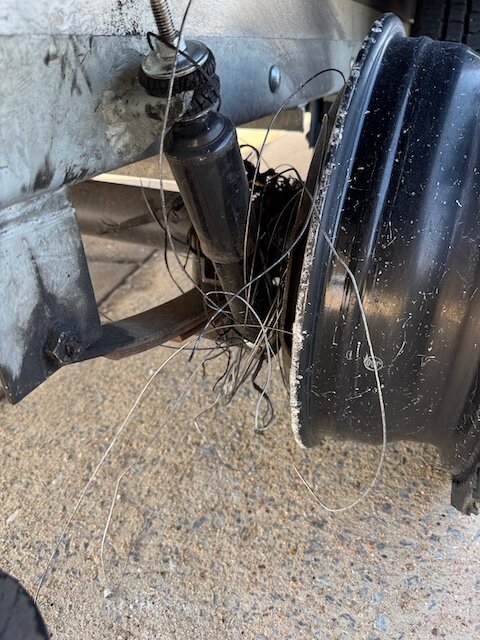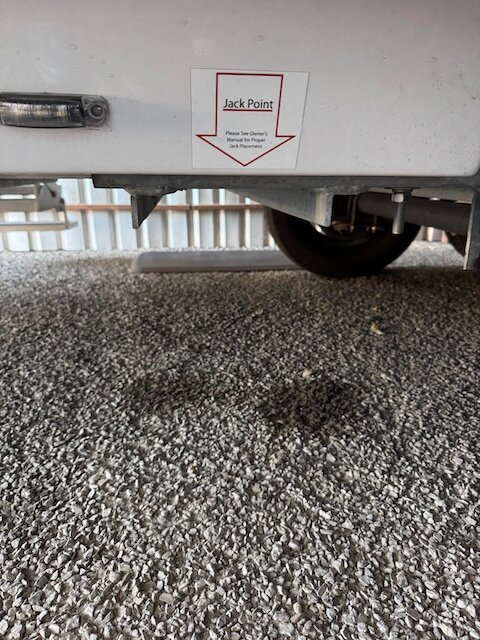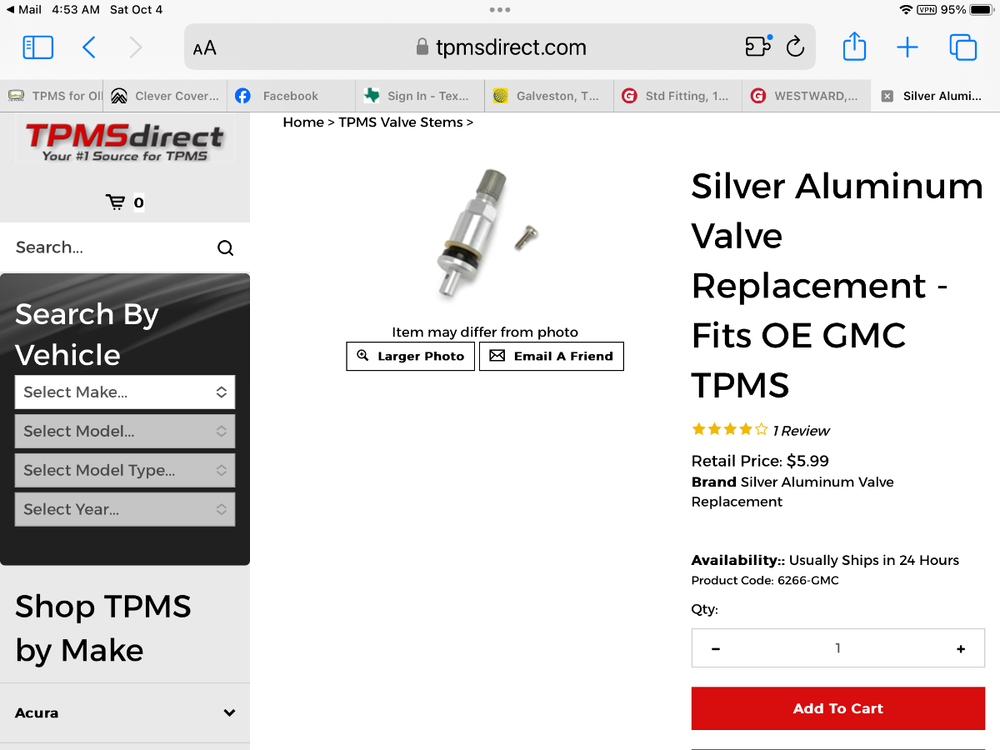Search the Community
Showing results for 'tpms'.
-
On our last trip, we had significant tire issues (we replaced two tires, one valve stem, and one wheel), so I wanted to share a little of what we experienced and hope to hear from others on ways to make the next time easier. What happened: Entering Wichita Falls, TX on US-281 from the south driving around 60-70 mph, we heard an unfamiliar noise that we couldn't place or locate. The noise would come and go. Five miles later we exited the freeway onto the frontage road, stopped on the shoulder, and hopped out to make sure everything was alright. It wasn't. The right (curbside) rear (RR) tire was gone. Its wheel was an aluminum nub. Some thoughts: Our LE2 handled fine. I think the weight distribution hitch/anti-sway really helped. The noise coming and going was due to us driving near concrete barriers on the side of the road that reflected the noise back to us, such as on a bridge. When we were on straight road, we couldn't hear or feel anything. We were lucky. No damage other than scratched gel coat. There was a considerable amount of steel cable wrapped around the axle and brake area. Taking the tire off: The first task was to get the trailer "jacked up". We pulled forward onto our Andersen Rapid Jack to elevate the right, front (RF) tire. This worked well until the RF tire went flat also. In addition, taking the weight of the trailer off the RR wheel made it more difficult to remove the lug nuts. Fortunately, a passerby stopped to help us and had a powerful impact wrench and an extender since the lug nuts are recessed quite a bit and the center dome got in the way of the wrench. Also, my personal wire cutters were no match for the steel cables. We needed heavy-duty snips to remove all the cables. It was apparent that we were not fully prepared for this situation, so we called a mobile RV repair person. He ended up using a low-profile hydraulic jack to hold up the trailer. Some thoughts: If we had simply run over a nail, we would have been fine. The Rapid Jack would have been all we needed. I have to upgrade my wire snips and am struggling with choosing a hydraulic jack. A low-profile jack is bulky and heavy, can get into places with low clearance/uneven terrain, and has extended lift range. Bottle jacks are smaller and lighter, but have more limited lift range. Any thoughts on what you use? Where to place the jack? The trailer has a jack point for the frame, but, rightly or wrongly, the repair guy put his jack behind the wheel near where the bolts are in the photo below. Getting to our spare: This wasn't a big deal. We do have the rear bumper receiver but it slid out easily. I was glad that the spare had good pressure since I hadn't checked it in about a year. Some thoughts: Check your spare. I had even installed a tire valve extension (something like this) to make it easier to check and fill. Put this task on a checklist to do periodically. Putting a good tire on: A full light truck tire is bigger and heavier than a passenger tire. Also, a full tire has a larger radius than a flat tire which means the tire may need more clearance. Changing it on uneven ground introduces clearance issues if the axle is not up high enough. Since we had lost our tire, once we put the new one on, we spun the tire and checked for brake operation. We found a 3 second delay from the pedal push to the application of the brake on the wheel. This caused us some concern at the time, but both our technician and myself confirmed that the delay was due to the truck's brake controller. It's probably obvious, but put the wheel on and hand-tighten the lug nuts with the wheel off the ground and then tighten the lug nuts to the proper torque (we did have a torsion bar) when the wheel is on the ground and won't spin freely. Some thoughts: If you are going to check your trailer brake while the wheel is jacked up, use the manual control on your brake controller, not the floor brake pedal. A second tire went flat: Our hearts sank as we watched the RF tire lose pressure as the RR tire was replaced. We only had one spare. The technician's fix was to pull out a can of fix-a-flat and refill the tire with air. It was enough. Again, we were fortunate to have pulled off the road 2 miles from a great RV park, so we headed over with the technician following us to ensure we arrived safely. Some thoughts: Carry a can of fix-a-flat. Purchasing tires on a trip: The next morning the tire "repaired" with the fix-a flat was flat again. This time we refilled the tire ourselves and drove the trailer to a Discount Tire for a replacement. This store had a limited selection so we only replaced the one bad tire and risked driving to our destination one hour away with no spare. Before leaving, the store manager offered to "top off" all our tires. In the process of putting in air on the left (street) side tires, the TPMS sensors were very difficult to remove. To make a long story short, they were finally removed, the tires topped off, and we were off to our destination (Lawton, OK). Upon arriving in our campsite, a camper remarked that one of our left tires was low. It was flat. We don't know for how much of our hour-long drive it was flat. The next day I brought that tire into a Lawton Discount Tire where they replaced the damaged valve stem and I bought the only compatible wheel they had and a spare tire. Some thoughts: Fix-a-flat works for emergencies, but only to the nearest tire shop. Although limited by the store's available tire selection, it will be a cold day in hell before I ever drive the trailer again without a spare tire available. Lessons Learned: As we pulled away from home, all four of our trailers' tires had TPMS sensors on them. I never pulled out and turned on the monitor. It might not have prevented the blowout (or whatever it was that happened), but the alarm would have told us that there was a problem and we would have pulled over much earlier, reducing risk to ourselves and damage to the trailer. I thought I was prepared for tire issues. In fact, I was only prepared for the simplest, most basic scenario. The next time we go out, we'll have a few more tools. I'm interested to hear from you what's in your tire changing tool kit. Open issues: Still trying to figure out which type of hydraulic jack to bring with us. I'd appreciate your thoughts. Still trying to figure out the correct jack point. I'd appreciate your thoughts on this as well. We hope this has been helpful to some and interesting to others. Let us know your thoughts.
- 66 replies
-
- 16
-

-

-

-

-
Hi friends. Thinking of adding a TPMS to our Olly sometime in the near future. Would like your valuable opinions on what to look at and what to stay away from. Yes, mention brand names, please. 😁
-
Is anyone using the new Dill Bluetooth TPMS? If so, how do you like it? I’ve been using a Dill TPMS since early 2019 and I really like it. I don’t want a system that uses externally mounted sensors on the valve stems. It’s time to replace the sensors mounted inside the tire and I see that Dill has a new Bluetooth version available without the dash or windshield mounted display. https://www.dillvalves.com/product_cpt/1604-v-bluetooth-aftermarket-tpms/
-
If you're looking for a convenient place to hook up your TST repeater there is ample space within the front jack head. +12V power is available and you can utilize the existing power switch currently used for the lamp or add an additional switch if you choose to.
-
I don't have a 'shop' space or much in the way of equipment. Also, my TV came with a TPMS for the 4 tires (not the spare). I have some questions: - What's involved in the installation process? If a professional install is recommended, where does one go to have this done? - Are there any issues with adding a TPMS to a vehicle that already has one? - How much will an installation range in cost? Thanks to original poster, as this has been on my list of possible upgrades.
-

Changing tires in the wild - lessons learned
jd1923 replied to John and Jodi's topic in General Discussion
If you have rubber, make sure to install high-quality STEEL valve stems first. Buy from Summit or local auto parts store, NOT Amazon China-made. Tire companies do not carry them. https://www.summitracing.com/search?SortBy=BestKeywordMatch&SortOrder=Ascending&keyword=steel valve stems There are also TPMS sensors that can be installed inside of the wheel integral to the stem. More expensive and work required in removing the tires/rebalancing but it is the way the industry is going now that all modern vehicles have TPMS built-in. https://www.discounttire.com/accessories/tpms-catalog Best to have wheels balanced after TPMS sensors are installed. -
Our Tireminder TPMS system has worked well on our Elite II for the past 2+ years. I mounted the booster under the rear dinette seat, with a "hard wire" connection to an unused slot in the 12V fuse panel, which is within inches of the mounting location. https://www.amazon.com/Minder-Research-TM22141-TireMinder-Transmitters/dp/B082QJ7H1R/ref=sr_1_1?crid=1MSJDVAH45HLF&dib=eyJ2IjoiMSJ9.xBmn1bCjMiZcg7st2OKRkkfI4kSlleW3UGbbTyKzXFW58FCKkTvAYe6M8Bp6luDUhzXIvBvKfxxi-sUnw5Nb_7Yzkp6Y4sehv6btJXLRERwcnu-a38tUXuey3rYQfVKmmP5oC8bGLQSm53BfH59q5zN_q49xhIqjwjLESh6sXsSA4mZl8kNbNp0ptIxNL72RHSkyMFCfnDYPrvAreT8Bb3lh2GrZQMIOk63Zv-6-844.SpXlweze8XL29HUrVGukyQVBGJQWg2nE_LS6bo-7zSw&dib_tag=se&keywords=tireminder+tpms+for+rv&qid=1759517098&sprefix=Tireminder%2Caps%2C200&sr=8-1&ufe=app_do%3Aamzn1.fos.5998aa40-ec6f-4947-a68f-cd087fee0848 We use the factory TPMS system for the tires on our 2019 Tundra tow vehicle.
-
Changing tires in the wild - lessons learned
Roger replied to John and Jodi's topic in General Discussion
When I bought my F350 I got the trailer TPMS monitoring system. So far, I have been very happy with it. Unfortunately, the Ford TPMS cannot monitor the spares. The nice thing about the Ford TPMS is there is no sensor to have to fool with when I manually check tire pressures and I don't have another device cluttering my cab. My practice with spare tires is to keep them inflated to the maximum allowed for the tire and then lower the pressure to the correct pressure when I use the spare. I also carry an inflator so in the worst case I can add air to the spare. I think I will add checking the spare tire pressure to my travel checklist, although it is a hassle to check the pressure on the Oliver spare. When I got my new truck, I lowered the spare and flipped it around (Ford has the spare with the valve up from the factory) so that I could check the pressure with it mounted under the bed. -

Changing tires in the wild - lessons learned
topgun2 replied to John and Jodi's topic in General Discussion
As do most all of the TPMS brands that I know of to include my EZE Tire. My comment was referring to those TPMS systems that are included with most (if not all) newer vehicles. My F-150 does monitor the four tires on the truck but it doesn't monitor the truck's spare tire nor does it have the ability to monitor anything on the Ollie. Someone recently made a post that said their new truck did allow the monitoring of TPMS sensors on a trailer in addition to those on the truck. Bill -

Changing tires in the wild - lessons learned
topgun2 replied to John and Jodi's topic in General Discussion
Glad you guys are OK and that there wasn't any more damage than you had. I believe that your experience was ( as you mention) partially your "fault" due to not turning on your TPMS. However, the extent of your tire issues is very extraordinary. I don't think that you can prepare for every possible situation while on the road - unless, perhaps, you are ScubaRx 😇. Yes, checking your spare tire air pressure should be done more often OR simply get yourself another TPMS sensor for that spare and remember to turn that TPMS monitor on. I also agree with the advice concerning the use of the onboard "leveling" jacks. Your experience is yet another reason why we bought an Oliver and believe that everyone should consider before purchasing virtually any other brand. Bill -

Changing tires in the wild - lessons learned
Steve and MA replied to John and Jodi's topic in General Discussion
We've had two rubber valve stem failures on our LE2 fitted with TPMS sensors. Fortunately, both were slow leaks. Rubber stems can crack due to the flexing from the extra weight of the sensor. Ours are TPMS sensors from TST that they claim can be used on rubber valve stems. Our TV has metal valve stems also fitted with TPMS sensors, but they're not immune to failure. Even the rubber gasket on a metal stem can leak. I think part of the problem is that the sensors are difficult to remove, so the stems get flexed more than they should when adjusting tire pressure. As already mentioned, the electric jacks can be used for tire changing as long as you're still hitched and the TV parking brake is set. It's much more convenient than carrying another jack. Also, is the wire wrapped around the axle from the tire's steel belts? -
My Savana van has built in tire pressure sensors and dash display monitor, but that TPMS system will not alert me if there is an on-going issue indicating a tire going flat or wheel overheating. If upgrading to metal valve stems to accommodate a secondary TPMS system, it is important to know that replacements are vehicle specific to ensure proper fitment to the stock wheel sensors. I acquired a set for the van, as shown below, and had them installed at Discount Tire for a nominal fee.
-
Search the OTT Forum for 'TPMS' to get these suggestions and so many more. 🤣 This subject has been covered 10x! A small few of us, would not mount a sending device on a tire fill valve, there are issues! Given this thought, you may want to consider a professional installation, e.g. consider this thread, just started a few days ago... https://olivertraveltrailers.com/forums/topic/11078-dill-bluetooth-tpms/
-
I thought of getting extra sensors, but went with the ViAir compressor to just air up those spares if needed. Since there's a tpms system built into the tv, I could just move one from the tv and put it on the trailer. Maybe overkill to have duplicate tpms on the tv, but if that happens, I could then buy an extra sensor to replace what I used from the tv. John
-
There are a ton of different brands - just type in "TPMS" on Amazon. Also, do the same on YouTube to view many different brands as tested by "professionals". Just about all of these do the same thing while having slightly different monitors. I would tend to stay away from the "cheaper" brands and would also question what am I getting for my extra money on the more expensive brands. Simply put - this is NOT new tech anymore other than those that are starting to integrate the trailer's TPMS with that of the tow vehicle. Bill
-
TPMS sensors are user installable if you purchase the sensors that screw onto the valve stem. Internal (to the tire) sensors require professional installation. You will also need professional installation if you need to replace rubber valve stems with metal. While some have good results without switching the stems, my TST flow-thru sensors require metal stems (per the TST instructions). After a shop replaced my rubber valve stems with metal stems, I installed and calibrated the sensors following the instructions.
-
If you go with TST the install process is simple. It does not interfere with your TV system as it uses its own monitor (display). You simply put a battery in each sensor, screw the sensor on to the tire stem, then configure the sensors on the monitor (following the instructions). Done. We’ve had ours for 9 years with no problems. I’m sure the other TPMS’s are similar. Mike
-

Changing tires in the wild - lessons learned
Patriot replied to John and Jodi's topic in General Discussion
Tony, I and others on here have been running the 507 TST TPMS. I can’t speak for others, but our system has served us really well for the last 5.5 yrs in. TST I think is based out of Georgia and their customer service is nothing short of stellar. As @Mike and Carol mentioned it measures pressure and tire temp as well. I run the Discount tire rubber stems and have been happy very with this set up. Not to go down the rabbit hole on tire stems, but….metal stems can bend and leak on impact from road debris especially if off pavement. My guys at DCT did NOT recommend metal stems. It’s a personal choice. Go with what your happy with and works. As @topgun2 suggests get the 6 pack of stem cap monitors so you have a sensor for your spare and have an extra. The rubber mount that the TST dash monitor is cradled in works nice and keeps it from moving around on the dash. I use it all the time. For warranty reasons, TST requires you run the repeater which is an easy 12v hook up. I attached mine to the interior of the battery box with velcro. If you decide on this TPMS hit me up with a PM if you have any install questions. It’s pretty straight forward. Once you have your tire caps on and “synch up” with your charged up dash monitor, you are good to go. I think the battery is a 2032 which is installed in each tire sensor. I change these out once per year. This is amazon’s price, shop around you may find it cheaper. https://www.amazon.com/dp/B07FKTH136?tag=track-ect5-usa-1802408-20&linkCode=osi&th=1&psc=1 Safe Travels! -

Changing tires in the wild - lessons learned
Mike and Carol replied to John and Jodi's topic in General Discussion
Wow, glad you were able to resolve with no accident or damage! Thanks for the write up, it’s proof how well the Oliver tows. General thoughts: Use the onboard leveling jacks. We’ve been doing this for years, to include at Discount Tire on a few occasions and at campgrounds to remove wheels. The TST TPMS shows both pressure and temperature of each tire. I keep the monitor on the dash and do a visual check every 15 minutes or so. Whatever TPMS you use, use it and keep a regular watch on tire health. Mike -
This has been discussed and posted many times (and 3rd time I posted this picture). Everybody should download a table like this for your tire make/model/load range (E) and size, however the numbers are basically the same across manufacturers, but vary greatly by tire Load Range (# tire ply) and SIZE. This table is for the tires we have on our Oliver, but should be good for any Load Range E size 225/75R16 tire. Running 4 tires at 60 PSI will safely support a trailer up to 9,740 lbs. Running as low as 40 PSI is enough for a 7K trailer (7,180 lbs). Before travel, I'll check pressure on all 4 trailer tires (the truck too of course). If the Oliver tires are all within 42-46 PSI, I'll level them off to the lowest common denominator (easier to let out air than to fill). Less than 42, more than 46, I'll make them all very close to 45 PSI, providing a 10% margin over the required PSI for the GTWR (more margin for reaction time to TPMS, not a good idea). The tandem-axle trailer design with the center equalizer of the EZ Flex system, allows the leaf springs, one axle at a time, to have a longer span length to absorb bumps, or shorter to absorb dips. Better to hit a speed bump, bridge seam, pothole with stiffer springs vs. higher PSI tires! The years that OTT recommended 80 PSI (65 or 55), I promise you "punished" the Oliver build much more than Alcan HD springs! 🤣
-
We went with a “cheaper” brand. We have had it a year and so far are very happy with it. I would at least say cheaper is better than nothing at all in the case of a TPMS.
-
Of course you can do this - but Many times those spare tires are not easily accessed. In the Ollie you either have to purchase a valve extension or basically remove the spare in order to simply check that spare's pressure. With my F-150 I would have to lower the spare from its position up under the bed of the truck before I could check its pressure. The extra TPMS sensor usually saves me the effort of dealing with both of these "problems". Bill
-
The TST system was the first purchase I made before we picked up our Elite2 in Tennessee in 2022. I wouldn't consider towing a trailer without some tpms on the wheels of the trailer. I have eight sensors and extra batteries. Four on the tv and four on the trailer. I carry a ViAir air compressor also to air up as needed. John
-
We've used the TST system for many (10+) years. We replaced the stock rubber valve stems with steel ones first. (These fit our 2022, YMMV: https://www.oreillyauto.com/detail/c/xtra-seal/tire---wheel/tire-valves---caps/tire-valves---cores/aede909cf322/xtra-seal-bolt-in-valve-fits-rim-hole-diameter-5-8-inch/xts0/17428 ) Definitely get a TPMS, regardless of brand.
-
We have used this system for several years and are very happy with it. I cannot imagine towing our Oliver without it. https://www.amazon.com/TST-507-TPMS-Cap-Sensors















